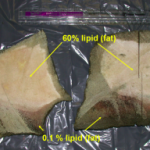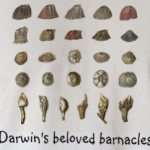
Lucernaria janetae (Cnidaria: Staurozoa: Lucernariidae)
Stauromedusae are not entirely uncommon, but not entirely common either. In fact “stalked jellyfish”, as they are sometimes known, are very rare in the deep sea and only about 50 species are described (5). Only one other has been reported from abyssal depths (Lucernaria bathyphila). These strange jellies are making more appearances along the East Pacific Rise.
“A Lucernaria … may be compared in form to a goblet or a funnel with double walls” (6)
Description L. janetae was described in 2005 from specimens at 8N on the East Pacific Rise and named in honor of Janet Voight, the chief scientist of the expedition and curator of invertebrates at the Field Museum. It is large for a stauromedusan at up to 10 cm wide (minus the peduncle, or “stalk”), kind of like a gelatinous softball… or a large gelatinous wine glass perhaps? Most stauromedusae are less than 5cm long (5).

Its color is white, slightly transparent with orangish-pinkish gonad. The peduncle is single-chambered, which is interesting since most stauromedusae have 4 chambered peduncles (1). The “bell” part is separated into 4 septa, each with 2 bundles of about 100 tentacles held above the margin of the bell.
Physiology Nothing is known about its physiology. It lives near diffuse venting and therefore may have adaptations to deal with toxic chemicals and heavy metals. This may also not be as important since they live on the periphery of the vent-zone, though some observations have documented cloudy water moving over the stauromedusae (2, 7).
Nutrition Stauronedusae typically feed off small crustacea in the water column. At the 8N site, swarms of the amphipod Halice hesmonectes occur in the stauromedusan field. This likely constitutes the main food source of L. janetae (7). Interestingly, H. hesmonectes collected above the stauromedusan field consisted of significantly more reproductively mature females than those collected over tubeworms. This would be an additional lipid-rich bonus for the stauromedusae (7).
Reproduction Reproductively active L. janetae have an orangish or yellowish tint, which is the color of its gonad. Stauromedusae are characterized by unciliated, crawl-away planulae. This has implications for limited dispersal. On the contrary, it is interesting that L. janetae likely represents the species from reports of stauromedusae at other vent sites along the northern and southern EPR (1-4, 7). How this species traverses a non-linear mid-ocean ridge tract spanning from 21N to 7S is fantastic question for a population level genetics study.

Ecology Lucernaria janetae is the first and (so far) only species of stauromedusae ever described from a hydrothermal vent. They are only documented from diffuse venting and have not been observed on hydrothermal chimneys. They can occur in densities of greater than 100 individuals/m2 (4). Though L. janetae was originally described from specimens from 8N, those at videotaped at 21N and collected at 7S (2) and 20S (3) are likely the same species. At all sites, bythograeid and galatheid crabs, the siboglinid polychaete Tevnia jerichonana and amphipods, likely Halice hesmonectes but may include other species and crustaceous plankton, are present in the stauromedusan fields. Cyananthea sp. and an “orange” anemone, likely from the genus Chondrophellia, were found in association with stauromedusae at 21N (4) and 7S (2). At 8N, juvenile (up to 5.5cm) the chemoautotrophic bivalve, Bathymodiolus thermophilus, was collected from among the stauromedusan field (7).

Biogeography L. janetae is the first Lucernaria to be described outside of the Atlantic (1). At depths between 2500 and 2700 m, L. janetae is second only to L. bathyphila (2800m, northeast Atlantic) as the deepest living stauromedusan (4). Due to its potentially highly limited dispersal phase, it is unclear how this species moves to new vent sites.
Images (in order of appearance) courtesy of Janet Voight and the Field Museum, Peter Batson, MBARI, Todd Haney
Further Reading
1. Collins, A. G., and M. Daly. 2005. A new deepwater species of Stauromedusae, Lucernaria janetae (Cnidaria, Staurozoa, Lucernariidae), and a preliminary investigation of Stauromedusan phylogeny based on nuclear and mitochondrial rDNA data. Biological Bulletin 208:221-230.
2. Halanych, K. M., M. Tieger, G. D. O’Mullan, R. A. Lutz, and R. C. Vrijenhoek. 1999. Brief description of biological communities at 7°S on the East Pacific Rise. InterRidge News 8:23-27.
3. Lutz, R. A., A. G. Collins, E. R. Annis, A. J. Reed, K. Bennett, K. Halanych, and R. C. Vrijenhoek. 2006. Stauromedusan populations inhabiting deep-sea hydrothermal vents along the southern East Pacific Rise. Cahiers Biologie Marine 47:409-413.
4. Lutz, R. A., D. Desbruyères, T. M. Shank, and R. C. Vrijenhoek. 1998. A deep-sea hydrothermal vent community dominated by stauromedusae. Deep-Sea Research II 45:329-334.
5. Mills, C. E. 2007. Stauromedusae: list of all valid species names. http://faculty.washington.edu/cemills/Staurolist.html. [April 2007].
6. Müller, O. F. 1863. Translations: On the genus Lucernaria. Quarterly Journal of Microscopical Science 2-3:265-285.
7. Voight, J. R. 2006. Stauromedusae on the East Pacific Rise. Cahiers Biologie Marine 47:347-352.





